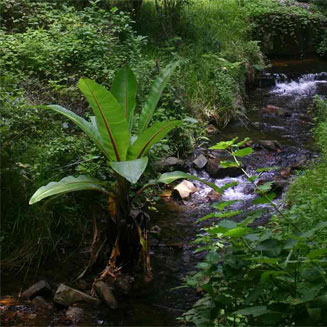Ensete ventricosum (Wild banana) Afrikaanse Wildepiesang [Afrikaans] Life
> eukaryotes >
Archaeoplastida >
Chloroplastida
>
Charophyta > Streptophytina > Plantae (land plants)
> Tracheophyta (vascular plants) > Euphyllophyta > Lignophyta (woody plants)
> Spermatophyta (seed plants) > Angiospermae (flowering
plants) > Monocotyledons > Order: Zingiberales
> Family: Musaceae
 |
 |
|
Ensete ventricosum (Wild banana), under
cultivation in Kirstenbosch Botanical Gardens, Cape Town. [photo H.
Robertson ©] |
Ensete ventricosum, Bridal Veil Falls,
Chimanimani, Zimbabwe. [photo Bart Wursten ©,
Flora
of Zimbabwe] |
Description
Grows into a tree up to 12 m high, with a
radiating crown of banana-like leaves, each leaf measuring up to 6 m
long. Flowers are borne in 1-1.2 m long spikes and hidden within
cylinders of bronze-red bracts. Fruit look like small bananas but
are packed with small pea-sized seeds and do not contain the soft
flesh one would like to exspect.
Distribution and habitat
This is the only native banana species found in southern
Africa. In South Africa it is found in the Limpopo province in forests with high
rainfall, occurring usually in ravines and along streams. It also occurs in
eastern forests of Zimbabwe and further north as far as Ethiopia.
Uses by humans
In Ethiopia, food is obtained from pulp in the stems and rootstock,
and the remaining fibres are used for making ropes and sacking.
Links
References
- Palgrave, K.C. and Palgrave, M.C. 2002. Trees of Southern Africa. 3rd
Edition. Struik Publishers, Cape Town.
|
| |
